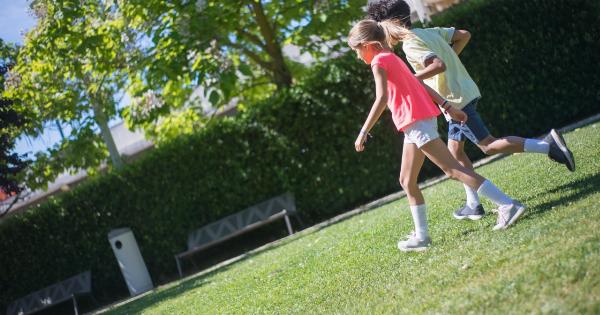In recent years, there has been a significant rise in the number of children being diagnosed with myopia, also known as nearsightedness. Myopia is a condition that causes distant objects to appear blurry, while close objects remain clear.
This visual impairment can have a detrimental effect on a child’s daily life, affecting their ability to focus in school and engage in outdoor activities. However, recent studies have shown that increasing a child’s time spent outdoors can help in lowering the risks of myopia.
In this article, we will explore the connection between myopia and outdoor time, and discuss the various ways parents can encourage their children to spend more time outside to protect their eyesight.
Understanding Myopia
Myopia is a refractive error caused by a combination of genetic and environmental factors. It occurs when the eyeball grows too long or the cornea is too steep, resulting in the light entering the eye not focusing correctly on the retina.
As a result, distant objects appear blurry, while nearby objects remain clear. Myopia typically develops during childhood and progresses until early adulthood.
The Rise of Myopia in Children
Over the past few decades, the prevalence of myopia has been steadily increasing worldwide, especially in urban areas. In some regions of East Asia, the rates of myopia among children have reached epidemic proportions.
The exact cause of this sharp rise is still under investigation, but researchers believe that lifestyle factors, such as increased screen time and reduced outdoor activities, play a significant role.
Link Between Outdoor Time and Myopia
Several studies have found a compelling association between the amount of time children spend outdoors and their risk of developing myopia.
Researchers have hypothesized that exposure to natural light and the distant focus of outdoor scenery, as well as the increased physical activity, may help prevent the elongation of the eyeball, a key factor in myopia development. While further research is needed to fully understand the mechanics behind this relationship, the evidence so far points towards a protective effect of outdoor time against myopia.
The Importance of Sunlight
One of the leading theories about the protective effect of outdoor time on myopia is the presence of natural sunlight. Sunlight is a primary source of vitamin D, which plays a crucial role in numerous physiological processes, including eye health.
Studies have shown that vitamin D may influence the growth and development of the eye, potentially helping to prevent the elongation of the eyeball that leads to myopia. Spending time outside exposes children to natural sunlight, ensuring an adequate intake of vitamin D and reducing the risk of myopia.
Role of Physical Activity
Increased physical activity is another important factor in reducing the risks of myopia.
Children who spend more time outdoors are naturally more active, engaging in various activities that involve a greater use of distance vision, such as sports or playing in wide-open spaces. These activities require the eyes to focus on objects that are farther away, exercising the eye muscles responsible for distance vision and potentially slowing down the progression of myopia.
Screen Time vs. Outdoor Time
Excessive screen time has been identified as a contributing factor to the increasing prevalence of myopia in children.
With the proliferation of smartphones, tablets, and computers, children are spending more time engaging with near work activities, such as reading, playing video games, or studying on electronic devices. Prolonged near work puts strain on the eyes and encourages myopia progression. Encouraging children to balance their screen time with outdoor activities can help mitigate the negative effects of extended near work and protect their eyesight.
Strategies to Increase Outdoor Time
As parents, it is essential to prioritize outdoor activities and create opportunities for our children to spend more time outside. Here are some strategies to consider:.
1. Set a Daily Outdoor Time Goal
Establish a goal for the amount of time your child should spend outdoors each day. Start with a realistic goal and gradually work your way up.
Encourage your child to take breaks from indoor activities and dedicate a specific time each day to play outside.
2. Plan Family Outdoor Activities
Organize regular family outings that involve outdoor activities such as hiking, biking, or picnicking. By making outdoor time a family affair, you can create lasting memories while promoting healthy habits for everyone in the family.
3. Create an Outdoor Play Area
Designate an area in your yard for outdoor play. Set up swings, slides, and other play equipment to make it inviting and fun for your child. Having a dedicated space will encourage your child to spend more time outside and engage in active play.
4. Encourage Sports Participation
Encourage your child to join sports teams or clubs that involve outdoor activities. Sports like soccer, basketball, or swimming not only promote physical fitness but also provide opportunities for children to spend time outside with their peers.
5. Limit Screen Time
Set reasonable limits on the amount of time your child can spend on electronic devices. Establish screen-free zones or hours in your home, promoting alternative activities such as reading, outdoor play, or family time.
6. Make Outdoor Time Fun
Provide your child with toys and games that encourage outdoor play. Bubbles, jump ropes, frisbees, or even a simple ball can make outdoor activities more enjoyable and enticing for children.
7. Be a Role Model
Children often mimic the behavior of their parents. Make an effort to spend time outside yourself and engage in activities that your child can participate in. Your enthusiasm for outdoor time will motivate your child to follow suit.
8. Emphasize the Benefits
Explain to your child the importance of spending time outside and the positive impact it can have on their eyesight and overall well-being.
Help them understand the benefits of being in nature, the joy of physical activity, and the opportunity to explore and discover new things outdoors.
9. Integrate Outdoor Time into Learning
Find ways to incorporate outdoor time into your child’s education. Take learning outside by organizing nature walks, science experiments, or art activities that involve natural elements.
This approach not only enhances their academic experience but also reinforces the connection between outdoor time and education.
10. Seek Professional Advice
If you have concerns about your child’s eyesight or myopia progression, consult an eye care professional. They can provide guidance tailored to your child’s specific needs and recommend appropriate interventions or treatments, if necessary.
Conclusion
In conclusion, the link between myopia and outdoor time in children is evident. By increasing the time children spend outside, parents can lower the risks of myopia and promote healthier eyesight.
Encouraging outdoor activities, limiting screen time, and setting positive examples are among the strategies parents can employ. Ultimately, creating a balanced lifestyle that prioritizes outdoor time not only benefits children’s eye health but also contributes to their overall physical and mental well-being.





























